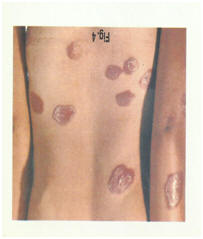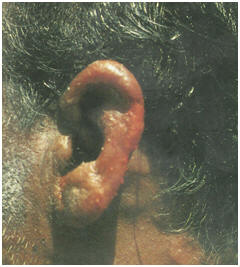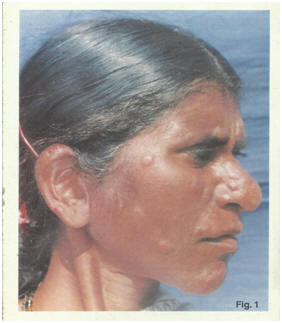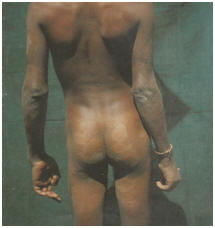


Damien Social Welfare Centre
DHANBAD, JHARKHAND, INDIA
in the service of humanity, 1964 onwards
Sponsor a child for her studies and food
Support for the Leprosy Patients
Home About us Health Services Education Services Rehabilitation Services Nirmala Nursing School Vocational Training
A Brief Information on Leprosy
What is leprosy?
It is a disease of skin and nerves.

What causes leprosy?
Leprosy is caused mainly by Mycobacterium leprae, a rod-shaped bacillus that is an obligate intracellular (only grows inside of certain human and animal cells) bacterium. It causes damages to the skin and the peripheral nervous system. This belongs to the same family as that of the bacteria that causes Tuberculosis. Mycobacterium tuberculosis. The disease develops slowly (from six months to 40 years!) and results in skin lesions and deformities, most often affecting the cooler places on the body (for example nose, earlobes, hands, feet, buttock and testicles). The germs probably enter the body through the nose and possibly through broken skin. The germs get in the air through nasal discharge of untreated lepromatous patients.
What are leprosy symptoms and signs?
Unfortunately, the early signs and symptoms of leprosy are very subtle and occur slowly (usually over years). Numbness and loss of temperature sensation (cannot sense very hot or cold temperatures) are some of the first symptoms that patients experience. As the disease progresses, the sensations of touch, then pain, and eventually deep pressure are decreased or lost. Signs that occur, such as relatively painless ulcers, skin lesions of hypopigmented macules (flat, pale areas of skin), and eye damage (dryness, reduced blinking) are experienced before the large ulcerations, loss of digits, and facial disfigurement develop. This long-term developing sequence of events begins and continues on the cooler areas of the body (for example, hands, feet, face, and knees).
Who is affected by Leprosy?
Anybody, regardless of age or sex, can get infected by Leprosy. However, children seem to be more susceptible than adults.

How to prevent Leprosy?
The best way to prevent the spread of leprosy is the early diagnosis and regular treatment of people who are infected.
At what stage Leprosy cannot be cured?
At every stage Leprosy can be cured
Is Leprosy contagious?
Yes, but leprosy is far less contagious than other infectious diseases. It seems that it is only contagious when a person has untreated leprosy. Once the disease has been treated, a person becomes noninfectious within a short period of time. Most specialists agree that more than 95% of the world's population has a natural immunity to the disease.
In addition, not all forms of this disease are contagious. For example, the tuberculoid or paucibacillary form is not contagious
Few myths about leprosy
 1. Leprosy is hereditary - this is not true; it is an infection. It might
be transmitted from parents to children because of
1. Leprosy is hereditary - this is not true; it is an infection. It might
be transmitted from parents to children because of
close contact, not genetically.
2. It occurs due to immoral behavior and is a punishment from God. Not true.
3. It is caused by faulty eating habits like eating dried fish – there is no research to prove this.
4. Transmission can be prevented by social boycott of the patient.
5. Leprosy is incurable - Not true either. It is curable to a large extent with MDT. With the prescribed dosage of medicines, patients become non-infectious within a specified period of time.
6. You can catch leprosy from touching someone who is affected.
You cannot catch leprosy from touching someone who is affected. In fact, 95% of humans are naturally immune to Mycobacterium leprae, the germ that causes leprosy. While it is still not known exactly how the disease is transmitted, long-term exposure to the germ in unsanitary conditions is one of the contributing factors.
7. Leprosy causes your fingers, toes and limbs to fall off.
Leprosy does not cause any body parts to simply fall off. The disease affects nerves in the hands and feet eventually causing them to become anesthetized; all sensation is lost. Those affected by leprosy, therefore, are at greater risk for cutting, burning or otherwise injuring themselves as their hands and feet do not feel pain. It's through cuts and burns that fingers and toes can be lost.
Anesthetized feet are also more susceptible to ulcers. If not treated and cared for properly a complicated ulcer can result in the need for a patient to have a foot or part of a leg amputated.
8. Everyone who has leprosy will become disfigured.
Leprosy does not necessarily result in claw hand or drop foot. If caught and cured early on patients will have no visible signs of the disease beyond some skin patches.
9. Those affected by leprosy cannot work or participate in community life.
Leprosy is fully curable and reconstructive surgery is available for those affected by claw hand or drop foot. Many leprosy affected persons are able to continue with work and actively contribute to their communities.
Photo Gallery